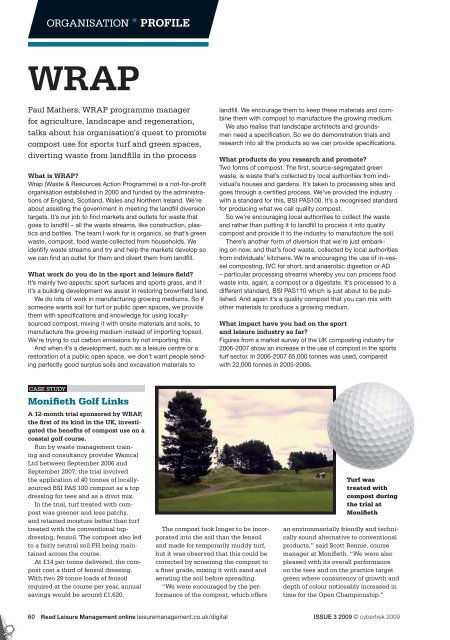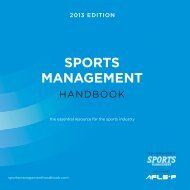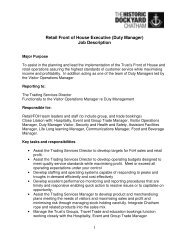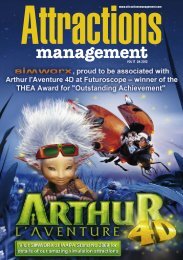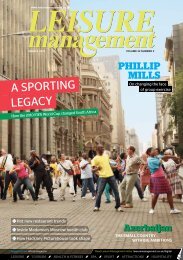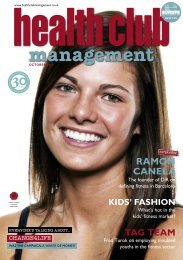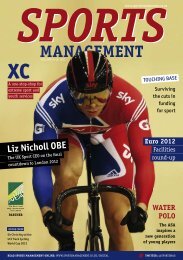Leisure Media Issue 3 2009 - Leisure Opportunities
Leisure Media Issue 3 2009 - Leisure Opportunities
Leisure Media Issue 3 2009 - Leisure Opportunities
- No tags were found...
Create successful ePaper yourself
Turn your PDF publications into a flip-book with our unique Google optimized e-Paper software.
ORGANISATION * PROFILEWRAPPaul Mathers, WRAP programme managerfor agriculture, landscape and regeneration,talks about his organisation’s quest to promotecompost use for sports turf and green spaces,diverting waste from landfills in the processWhat is WRAP?Wrap (Waste & Resources Action Programme) is a not-for-profitorganisation established in 2000 and funded by the administrationsof England, Scotland, Wales and Northern Ireland. We’reabout assisting the government in meeting the landfill diversiontargets. It’s our job to find markets and outlets for waste thatgoes to landfill – all the waste streams, like construction, plasticsand bottles. The team I work for is organics, so that’s greenwaste, compost, food waste collected from households. Weidentify waste streams and try and help the markets develop sowe can find an outlet for them and divert them from landfill.What work do you do in the sport and leisure field?It’s mainly two aspects: sport surfaces and sports grass, and ifit’s a building development we assist in restoring brownfield land.We do lots of work in manufacturing growing mediums. So ifsomeone wants soil for turf or public open spaces, we providethem with specifications and knowledge for using locallysourcedcompost, mixing it with onsite materials and soils, tomanufacture the growing medium instead of importing topsoil.We’re trying to cut carbon emissions by not importing this.And when it’s a development, such as a leisure centre or arestoration of a public open space, we don’t want people sendingperfectly good surplus soils and excavation materials tolandfill. We encourage them to keep these materials and combinethem with compost to manufacture the growing medium.We also realise that landscape architects and groundsmenneed a specification. So we do demonstration trials andresearch into all the products so we can provide specifications.What products do you research and promote?Two forms of compost. The first, source-segregated greenwaste, is waste that’s collected by local authorities from individual’shouses and gardens. It’s taken to processing sites andgoes through a certified process. We’ve provided the industrywith a standard for this, BSI PAS100. It’s a recognised standardfor producing what we call quality compost.So we’re encouraging local authorities to collect the wasteand rather than putting it to landfill to process it into qualitycompost and provide it to the industry to manufacture the soil.There’s another form of diversion that we’re just embarkingon now, and that’s food waste, collected by local authoritiesfrom individuals’ kitchens. We’re encouraging the use of in-vesselcomposting, IVC for short, and anaerobic digestion or AD– particular processing streams whereby you can process foodwaste into, again, a compost or a digestate. It’s processed to adifferent standard, BSI PAS110 which is just about to be published.And again it’s a quality compost that you can mix withother materials to produce a growing medium.What impact have you had on the sportand leisure industry so far?Figures from a market survey of the UK composting industry for2006-2007 show an increase in the use of compost in the sportsturf sector. In 2006-2007 65,000 tonnes was used, comparedwith 22,000 tonnes in 2005-2006.CASE STUDYMonifieth Golf LinksA 12-month trial sponsored by WRAP,the first of its kind in the UK, investigatedthe benefits of compost use on acoastal golf course.Run by waste management trainingand consultancy provider WamcalLtd between September 2006 andSeptember 2007, the trial involvedthe application of 40 tonnes of locallysourcedBSI PAS 100 compost as a topdressing for tees and as a divot mix.In the trial, turf treated with compostwas greener and less patchy,and retained moisture better than turftreated with the conventional topdressing,fensoil. The compost also ledto a fairly neutral soil PH being maintainedacross the course.At £14 per tonne delivered, the compostcost a third of fensoil dressing.With two 29 tonne loads of fensoilrequired at the course per year, annualsavings would be around £1,620.The compost took longer to be incorporatedinto the soil than the fensoiland made for temporarily muddy turf,but it was observed that this could becorrected by screening the compost toa finer grade, mixing it with sand andaerating the soil before spreading.“We were encouraged by the performanceof the compost, which offersTurf wastreated withcompost duringthe trial atMonifiethan environmentally friendly and technicallysound alternative to conventionalproducts,” said Scott Rennie, coursemanager at Monifieth. “We were alsopleased with its overall performanceon the tees and on the practice targetgreen where consistency of growth anddepth of colour noticeably increased intime for the Open Championship.”60 Read <strong>Leisure</strong> Management online leisuremanagement.co.uk/digitalISSUE 3 <strong>2009</strong> © cybertrek <strong>2009</strong>


